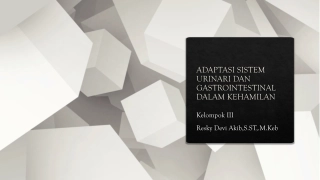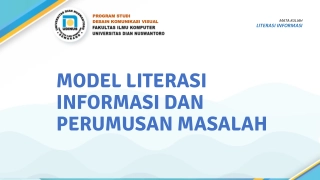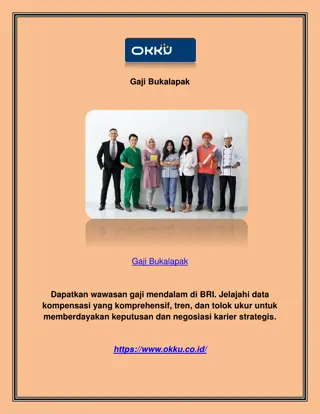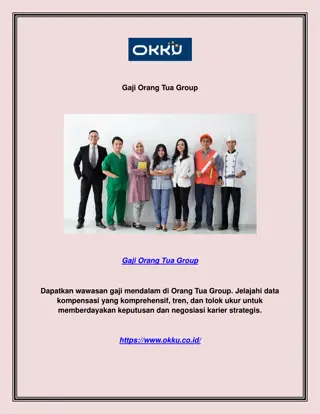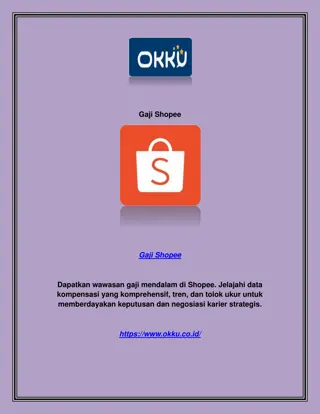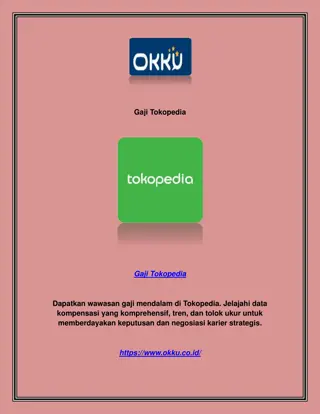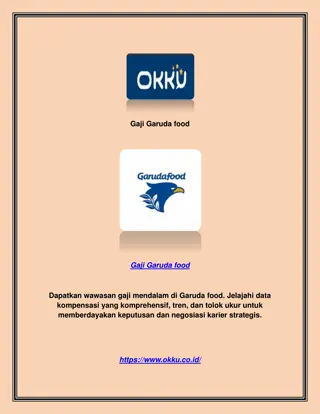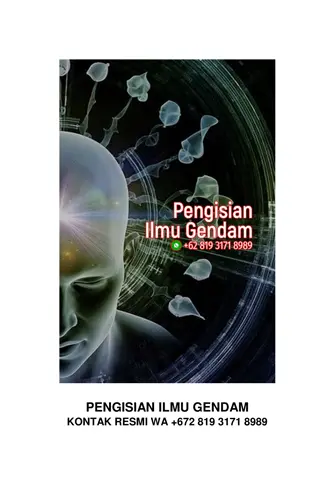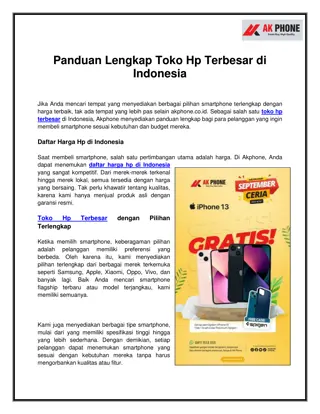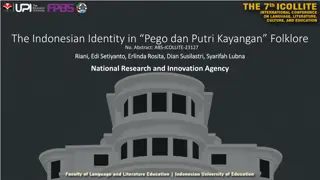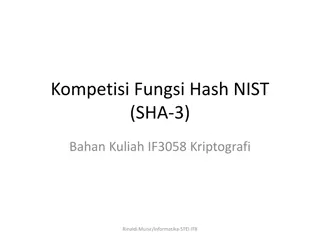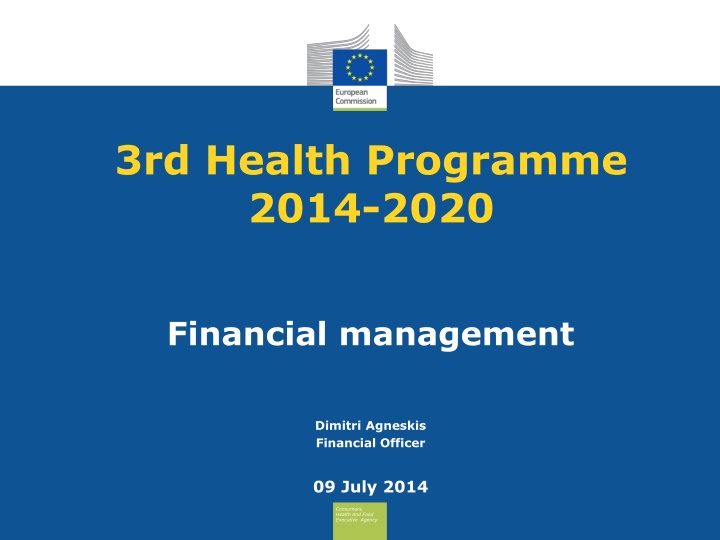
Financial Management Guidelines for 3rd Health Programme 2014-2020
Discover the key aspects of financial management, including eligible and non-eligible costs, principles, and co-funding rules for the 3rd Health Programme 2014-2020. Gain insights on managing grants, budget structure, and essential tips provided by Dimitri Agneskis, Financial Officer at Consumers, Health And Food Executive Agency.
Download Presentation

Please find below an Image/Link to download the presentation.
The content on the website is provided AS IS for your information and personal use only. It may not be sold, licensed, or shared on other websites without obtaining consent from the author. If you encounter any issues during the download, it is possible that the publisher has removed the file from their server.
You are allowed to download the files provided on this website for personal or commercial use, subject to the condition that they are used lawfully. All files are the property of their respective owners.
The content on the website is provided AS IS for your information and personal use only. It may not be sold, licensed, or shared on other websites without obtaining consent from the author.
E N D
Presentation Transcript
3rd Health Programme 2014-2020 Financial management Dimitri Agneskis Financial Officer 09 July 2014 Consumers, Health And Food Executive Agency
Table of Contents 1. General information 2. Budget structure 3. Nature of EC Contribution 4. Management of the grant 5. Tips and observations Consumers, Health And Food Executive Agency
1. General Information Consumers, Health And Food Executive Agency
Principles Definition: a grant is a direct financial contribution to an action or functioning of a body Co-funding rule: external co-financing from a source other than EC funds is required (own resources or financial contributions from third parties, project income) Non-profit rule: the grant may not have the purpose or effect of producing a profit for the beneficiary Non-retroactivity rule: only costs incurred after the starting date stipulated in the grant agreement can be co-funded Non-cumulative rule: only one grant can be awarded for a specific action carried out by a given beneficiary Consumers, Health And Food Executive Agency
Eligible costs Cumulative requirements Connected with the subject of the GA and included in the technical proposal and in the budget description Necessary for the implementation of the action Reasonable and justified goodhousekeeping Generated during the lifetime of the action Actually incurred by the beneficiaries, using applicable accounting principles Identifiable and verifiable, in particular being recorded in the accounting records of the beneficiary according to accounting standards and national law Consumers, Health And Food Executive Agency
Non-Eligible costs Return on capital Debt and debt service charges Provisions for future losses Interest owed, doubtful debts Bank costs charged by the beneficiary's bank for transfers from the Agency Currency exchange losses Costs declared by a beneficiary and covered by another action funded by an EU grant Contributions in kind Deductible VAT (linked to activity and not to legal entity) Consumers, Health And Food Executive Agency
Value-added Tax Non Deductible VAT ELIGIBLE The revised Financial Regulation, provides for the full eligibility of the cost of VAT when attributable to exempt activities or activities out of the scope (of VAT), except activities carried out as a public authority of a Member State. In other words, non-deductible VAT is eligible as expenditure, save for those activities matching the concept of sovereign powers exercised by Member States. Consumers, Health And Food Executive Agency
2. Budget structure Consumers, Health And Food Executive Agency
Cost categories Direct Costs 1. Direct personnel costs 2. Subcontracting 3. Other direct costs a. Travel costs and subsistence allowances b. Equipment c. Other goods and services Indirect Costs 4. Flat rate of 7% of total direct costs Consumers, Health And Food Executive Agency
Direct personnel costs Staff = employment contract or equivalent appointing act with one of the beneficiaries. Costs claimed: salary + social security + taxes Any other costs included in the remuneration (= statutory charges) based on national law or employment contracts Considered as personnel costs Costs of natural persons working under a direct contract with the beneficiary other than employment (on the beneficiary's premises, results belong to the beneficiary with similar costs of employment) Costs of personnel seconded by a third party against payment No differentiation on status of public / non-public officials. < Contact Human Resources / Accounting Department for data > Consumers, Health And Food Executive Agency
Subcontracting Contracts awarded to cover the execution of a limited part of the action. Part of activities undertaken by the project Service contracts Invoices (including taxes, charges, travel & subsistence costs) Core elements and technical / financial management of the action cannot be subcontracted. Tasks subcontracted must be set out in technical proposal. Requirement of transparency, best value for money or if appropriate, lowest price. Conflict of interest must be avoided. < Contact Procurement Department / Accounting for applicable rules and data > Consumers, Health And Food Executive Agency
Other direct costs Travel Travel & subsistence incurred as costs by the beneficiary for all participants, except subcontractors shall be claimed here: Personnel Collaborating stakeholders Invited experts, speakers Board members Trainees, other participants Costs should be in line with the beneficiary's usual practice and rules on travel and subsistence < Contact Human Resources / Accounting for information > Consumers, Health And Food Executive Agency
Other direct costs Equipment Specific equipment (software, PC, laptop, fee for licence, etc.) necessary for the action Costs eligible: Portion of equipment's depreciation costs only, for the period of the action, if recorded in the beneficiary's accounts. Purchase and depreciation is in accordance with international accounting principles and the beneficiary's usual accounting practices. Costs of renting equipment Cost of leasing equipment (excluding financing costs) Common software (Microsoft Office, Excel, Word,) are part of Indirect Costs < Contact Accounting Department for data > Consumers, Health And Food Executive Agency
Other direct costs Goods and services Costs of other goods and services are eligible, if they are purchased specifically for the implementation of the action Requirement of transparency, best value for money or if appropriate, lowest price. Conflict of interest must be avoided. Examples Dissemination of information Specific evaluation of the action Certificates of financial statements Translations, reproduction of reports Consumables and supplies (excluding general office supply) Conference fees, costs related to meetings / events Bank charges (cost of transfers to beneficiaries from the coordinator) Cost of financial guarantee, if applicable Consumers, Health And Food Executive Agency
Receipts Funding sources Co-funding from the EU budget: Financial contribution granted by European Union. Applicant's financial contribution: Own financial contribution provided by the applicants. Income generated by the action: Revenues linked to or generated by the action itself (e.g. admission fee to a conference, sale of equipment used, etc.). Financial contributions by 3rd parties: Other grants allocated at international / European / national / regional / or local level and/or financial transfers received from donors/sponsor specifically to be used for the eligible costs of the action. Consumers, Health And Food Executive Agency
3. Nature of EC Contribution Consumers, Health And Food Executive Agency
Nature of EC contribution EC Contribution = partial reimbursement of costs incurred by beneficiaries of the grant agreement at the reimbursement rate. Costs are assessed at the time of the periodic reports (interim and balance payments) Double-ceiling of EC contribution: maximum absolute amount + reimbursement rate applied to the consolidated total eligible costs of the action In case of over-expenditure maximum amount is paid In case under-expenditure reimbursement % is applied Consumers, Health And Food Executive Agency
Cash flow of the action Applicant's contribution Duration of the action: beneficiaries carry out activities, generate costs and record the costs incurred in their accounting system Starting date End date Interim report Contribution from 3rd party Income of the action: Conference fee Report approval, Assessment of costs, Reimbursement Report approval, Assessment of costs, Reimbursement Pre-financing payment Consumers, Health And Food Executive Agency
4. Management of the grant Consumers, Health And Food Executive Agency
Payments All payments are made to the coordinator. Pre-financing payment It provides beneficiaries with a float. It remains the property of the EU until the balance payment. It will be distributed by the coordinator if 90% of the beneficiaries sign the accession form and to only those beneficiaries who have signed it. Interim payments (one or more) Approval of periodic report + corresponding deliverables Payment is based on actual costs incurred during the reporting period and approved by the Agency. Calculation: application of the reimbursement rate on the approved eligible costs for the period. Total amount of pre-financing and interim payment is limited to 90% of the maximum EU contribution set in the GA Consumers, Health And Food Executive Agency
Payments Balance Payment Reimburses the remaining part of the eligible costs for the implementation of the action. Approval of final report + corresponding deliverables Establishment of the consolidated total eligible costs of the action and the final grant amount, refer to slides "Calculation of EU Contribution". Amount due is the balance of the final grant after the deduction of pre-financing and interim payments. The balance is a recovery, if the amount of earlier payments exceeds the final grant amount. Consumers, Health And Food Executive Agency
Supporting documents All activities generating costs must fall within the duration Events, meetings, delivery of consumables, services etc. +2 months: activities directly linked to preparation of the final report All debts must be established by the time the final report is submitted to the Agency Date of invoices and payments can be outside the duration Prior the duration (e.g. equipment, kick-off meeting) After the duration (e.g. service contracts, final conference) Type of supporting documents Timesheets, salary slips, invoices, contracts, purchase orders, acknowledgments of receipts / delivery, participants lists The amounts of cost items must be accurately established from the supporting documents and reconciled in the accounting records. No supporting documents for Indirect Costs Consumers, Health And Food Executive Agency
The final grant amount will be established at the time of the balance payment in 4 steps 1. Apply the reimbursement rate defined in the grant agreement. The Agency assesses and approves the cost claim of the beneficiaries (and its affiliated entities) and establishes the consolidated total eligible costs incurred for the whole action. 2. Apply the double-ceiling of the EU Contribution: Compare the resultof step 1 with the maximum amount of EU contribution defined in the grant agreement Maximum grant amount will be limited to the lower amount of step 1 and step 2. Consumers, Health And Food Executive Agency
The final grant amount cont. 3. Application of no-profit principle is it possible to pay the result of step 2? Profit is generated when the sum of the result of step and the action's consolidated total receipts is higher than the action's consolidated total eligible costs (step 1). Check: a) Has the action generated any income? b) Is there any third party contribution? If yes, calculate the sum (a + b) and add it to the result of step 2. Compare results of step 1 and step 3 If step 3 > step 1 the action would generate profit and the final grant amount should be adjusted 4. Reduction due to improper implementation of the action Consumers, Health And Food Executive Agency
5. Tips and observations of past experiences Consumers, Health And Food Executive Agency
Tips Double-ceiling to the EU Contribution Maximum amount of the grant Reimbursement rate of total eligible costs Recording the costs in the accounts by applying accounting standards, national law and usual accounting practices of the beneficiaries Number of associated partners All partners with specific knowledge crucial to the action Too many difficult to manage Higher share more commitment Avoid obvious over / under estimation Over-estimation may lead to decreasing of the final EU contribution Under-estimation: objectives might not be achieved Page 26 Consumers, Health And Food Executive Agency
Tips cont. Consult HR, Accounting and Procurement HR department who is staff, components of salary Accounting must have all available financial information and supporting documents Procurement / Sourcing contracts with third parties, applicable procedures Consortium Agreement Signed by each partner Internal project management, roles and responsibilities Project manager minded staff at coordinator and WP leaders, Financial manager at coordinator Read the grant agreement Page 27 Consumers, Health And Food Executive Agency
Thank you for your attention! Questions? Consumers, Health And Food Executive Agency

